How to Make Classic Génoise
Classic génoise is, well, a classic. However it can be a bit tricky, even for very experienced pastry makers. But when you want to make a classic Euro-style gâteau, nothing beats it for its lightness and its ability to keeps its integrity even after a liberal dose of cake syrup.
Here’ll I’ll add that if you’ve been burned too many times making classic génoise, you can always try what I call neo-classic génoise. It’s easier if a little bit sweeter. The drawback is that it can’t handle syrup quite like the ol’ stand-by.
To make génoise, have all your ingredients and implements ready ahead of time. That will allow your to move from one step to the next promptly (especially after the foam has been created).
The first step is to have your oven preheated to 350 and your baking pan — be it flat and shallow or round and deep — prepared and waiting. Once that’s done, you’ll want to finding a saucepan that will comfortably fit your mixer bowl, like so:
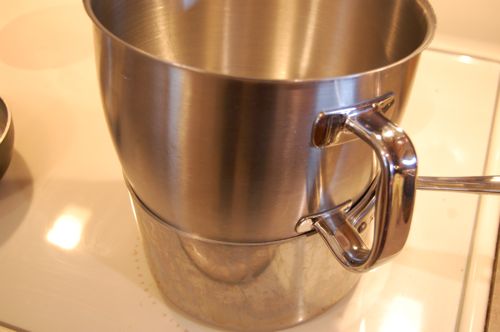
Take the bowl off the saucepan, put about an inch of water in it, and set it to simmer. Now then…sift your flour and salt into a medium bowl.

Off the stove top, add your sugar and eggs to the mixer bowl…
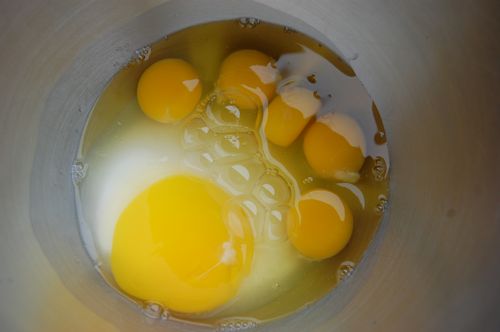
…and give them a good whisking.

Put the bowl over the simmering water and continue to whisk until the sugar is dissolved that the mixture is warm to the touch (no more than 120 degrees F).

Take the bowl off the simmering water and attach it to the mixer, onto which the paddle has been affixed. Beat on medium-high for roughly 8 minutes, until the mixture is extremely foamy. See that fat ribbon? As it rolls off the whip you want it to mostly just sit there on top.
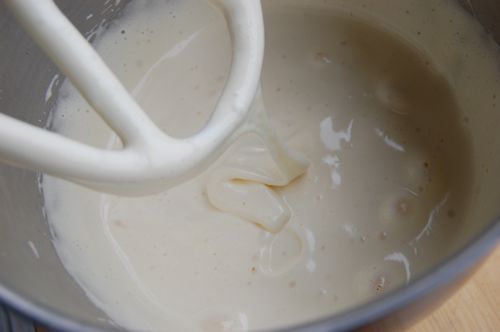
Now take about a cup of the foam and stir it into your melted (ideally clarified) butter. This will help the butter to more readily incorporate into the main volume of the batter.
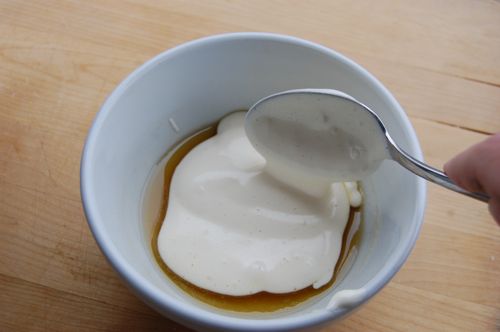
Stir until it looks about like so (no need to be gentle):

And gently pour the mixture back into the mixer bowl…

…sprinkle in the flour and salt…
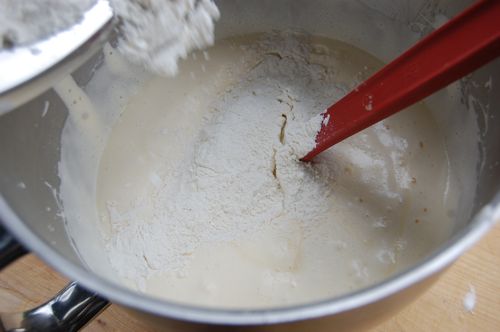
…and using your largest rubber scraper or spatula, fold until the mixture is uniform (instructions on how to fold properly are under the Techniques” menu on the left).
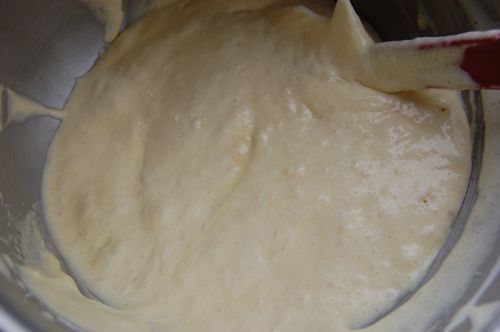
As for the form, this batter will fill either a 13″ x 18″ sheet pan or a 9″ x 2″ cake layer pan. Bake at 400 for about 10-14 minutes for a sheet and at 375 for 20-30 minutes with a 9″ cake layer.
Hey Joe, following your tutorial here, seems excellent so far. I did notice that the step about adding vanilla at the end of the egg / sugar beating is missing from the tutorial. It is in the recipe, just not the picture series. Will report back later when the cake is done, though. Your recipes have not failed me yet!
Hey Holly!
Thanks for pointing out the error. I’ll do my best to fix it. Meantime, do let me know how everything turns out!
– Joe
Don’t think of it as an error, think of it as a pop quiz, to see if the kids are paying attention!
My (first ever) genoise was … Ok. The texture was a bit tougher than I had hoped, although it is possible I simply did not apply enough syrup during the post-baking time.
I made a roll cake with it, filled with ginger mousse, sprinkled with powdered sugar. The mousse turned out Just So, which actually kinda highlighted the amateurishness of the cake.
However, the birthday boy and guests all had two slices, and leftovers for breakfast, so I can’t feel *too* bad about this! Good recipe, though, thanks!
Hey Holly!
Well I’m glad to hear that the overall product was well received. Funny thing about these sorts of sponges it that they are tougher than most people expect. That’s what gives them the elasticity they need to stay one one piece when they’re rolled.
Keep up the great work!
– Joe
Hi Joe, first time commenting here and firstly let me say I’m enjoying your blog immensely.
I’m a pretty good bread baker, but now I’m trying to learn pastry. I’ve discovered that people react being gifted a homemade eclair a whole lot better than a loaf of rye sourdough!
Made the classic génoise on the second try, the first one I didn’t manage to fold it in well enough, but it’s pretty great now!
I’m curious whether it would be possible to fold in the flour using a planetary mixer with a french whisk attachment running on the lowest setting and adding the flour in a few batches. Of course there’s only one way to find out, but I’d save myself the trouble if it’s something that’s been attempted and failed.
Hello Tadas!
And thanks so much for all the very kind words! Glad to hear about the génoise also, but to your question you can use a whisk attachment on low as well. A great many pastry chefs and students favor that technique!
Cheers and let me know how it goes!
– Joe
Hi I made Genoise first time today following these instructions – the cake tastes lovely, it rose perfectly, colour is as expected BUT I have one major issue – the cake is sort of rubbery – its soft and very light but when I break into it with a spoon it doesn’t fall apart or break up like a madeira cake would do – its sort of a bit rubbery – is this normal? or have I done something wrong?
Hey skhan!
Congratulations! Génoise is a little on the dry side…I wouldn’t call it rubbery myself but that’s not too far off the way I think about it. Most people who make tradition genoise compensate for its textural defects by brushing on cake syrup. Some people use a lot, I prefer a little less since I really don’t like a sodden cake. It’s a great way to introduce some more exotic flavors to the cake!
Again, VERY well done! A lot of culinary students have a terrible time make a génoise that rises!
Cheers,
– Joe